
There are no shortcuts when pursuing the ambition of Jumping Higher. There are no magic tricks that can be performed. Don’t let this blog allow you to think that there are!
However, with every jump training program you end up following, you will quickly realize that Plyometrics For Jumping is, always has been and always will be a popular and attractive option.
Plyometrics exercises feature prominently in the list of exercises we have compiled for you here - and on other training pages within this site.
Weight and Strength Training is also very good for jumping but the difference between you being a mediocre or a good jumper will almost always be determined by the explosive power that you are able to generate when taking off. The exercises we have included below address this very facet of jumping activity - creating and storing power in the leg muscles.
the Six Best Exercises To Jump higher
1- Drill Name: Seated Box Jump
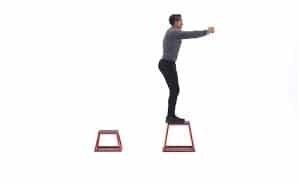
Drill Direction:
Start the drill from a sedentary position, with the knees flexed at about 90 degrees.
In front of you will be another box or elevated platform, which you will then jump onto, virtually from that sedentary position.
The moment your buttocks leave the seating platform, you will push off from your lower body muscles, and the hips.
So, there is no pause or additional consideration to be made. Just explode off the box with everything that you have in the tank.
The faster you shoot up onto the box, the better.
Do not stand up or gather yourself before jumping onto the second box!
Drill Repetitions: 4-6 Jumps Per Set
Drill Sets: 3-4 Sets Per Session
2- Drill Name: Judo roll jump
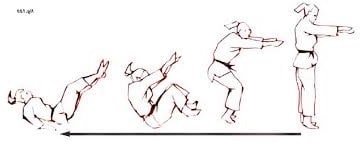
Drill Direction:
Start this drill while lying down on your back, with your head facing up.
When you are ready, pull your knees in towards your chest.
Once tucked in, you should then cross your left ankle over your right ankle.
Use your abdominal muscles to roll yourself up into a seated position. Make sure you do not yield to the temptation to use your hands for support or anything like that. This is all about maximizing your abdominal strength.
When you are in that seated position, make sure that your left foot is on the floor, as you prepare for the most difficult part of the drill.
Explode into the air with your left foot and land on it while you are standing before rolling back down into your original position.
It would be prudent to complete a series of reps with one leg, before alternating onto the other leg.
Don’t try to settle yourself throughout this motion, which should really be as fluid as possible. The smoother the motion, the better off you should be.
Drill Repetitions: 5-10 reps
Drill Sets: 2-4 sets
3- Drill Name: Medicine Ball Broad Jumps

Drill Direction:
We have heard this one before, but we will say it anyway. Start the drill standing in an athletic position. Knees slightly bent and hips slightly flexed.
Lower your body, into a squatting position and as low as you can handle. Usually the knee flex for this is more than 90 degrees.
Having stored that elastic energy you should then explode straight up.
All the while the medicine ball would have been clutched in your two hands and held up slightly in front of your torso.
When you explode up, you also need to explode as far forward as possible. For those who were born this century - and possibly for those who were born shortly before the end of the last - the long jump in track and field competition used to actually be called the broad jump. So, this drill is a long jump without the run-up or the sand.
Every time that you land, you should try not to slow down, stabilize or recover. Try to think of a frog on the water. There is no room for error, no room to break the rhythm.
Drill Repetitions: Six jumps per set should be just the tonic
Drill Sets: Anything between 3-4 sets per session should be more than sufficient
4- Drill Name: Depth Jump
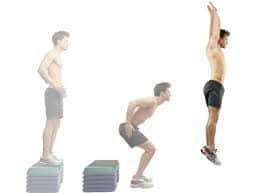
Drill Direction:
Find yourself an elevated platform. A box or even a stable chair and bench will count. It is not a complicated business.
Step up onto that first elevated platform when you are ready to start
You are going to then drop down from that elevated platform and the moment that you touch down on the floor, you must explode into the air.
The goal is to jump as high into the air as possible.
Do not be afraid to use the arms to help propel you into the air
As a progression from this, instead if just jumping up into the air, you can actually add another elevated platform into the mix and jump onto that platform once you have landed on the ground
Drill Repetitions: Anything between 4-5 repetitions should be just handy with these.
Drill Sets: Four sets per training session will help you increase your vertical, no question
5- Drill Name: Kneeling Jump
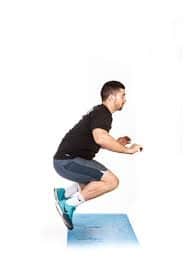
Drill Direction:
You will start this drill while on your knees, a bit awkward for some people with unfiltered minds. But we digress.
Then you should drive through your hips, explode up and subsequently land on your feet.
The key of this drill is also to land in an athletic position, which would confirm that you got some meaningful height and fight time from your jump. What that would obviously mean is that you produced or generated significant explosive power from the ground up
You are also pushing off the ground from the balls of your feet, which is particularly relevant in the context of jumping.
As a form of profession, you can then complete a broad jump once you have landed, or you can do a vertical jump once you have landed in an athletic position. You don’t have to take it that far but a challenge is always good if you want to increase the height of your vertical jump
Drill Repetitions: Anywhere between 4-5 repetitions will get you to where you need to go.
Drill Sets: Four sets per training session will help you reach your vertical jump goals.
6- Drill Name: Maximum Height Jumps
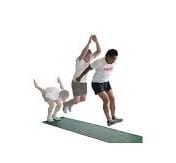
Drill Direction:
- Find yourself something that you want to touch, which requires you to eliminate some kind of height deficit. That can be an arch in or on a building, that could be a basketball hoop and that could be a volleyball net, take your pick. Find something that requires you to jump and tap while airborne.
- Start the drill in a standing position, before executing a countermovement and subsequently jumping as high into the air as possible. The whole point of the arch or the net or indeed the basketball hoop, is to try and challenge and stimulate yourself in some way while also training your body to jump higher.
- With this drill you can do either One Foot or Two Feet Jumping. You can also perform a standing jump or a running jump. You can do them all, really!
Drill Repetitions: You want to do anything between 4-5 repetitions for this routine
Drill Sets: You also want to do about four sets per session with this routine, to help you Jump Higher
Why Should You Add This Jump program To Your Jump Training
These Workouts To Jump Higher will help you increase your vertical or get you jumping higher, by increasing the explosive power output from your legs.
These Jump Workouts help with the development of strength in your legs and joints. All the muscle groups required for jumping are incorporated in these exercises too. They include the calves, glutes, hamstrings and quads.
Tips To Improve Your Vertical Leap
- If you can fix and master your technique, you can significantly improve your vertical leap. A compelling detail about technique is that it doesn’t change drastically over a long period of time. A good jump technique today will remain a good jump technique decades from now. Implementing the right basic technique allows you to maximize your vertical jump potential.
- If you want to increase your vertical jump, you should try to jump with dorsiflexion. It is a big word but what it essentially means is that you need to master the weight transfer in your feet when taking off into the air. When preparing to jump, the natural movement will be for your foot to point upwards towards your shin. Starting the jump motion from this position helps you push off your heels better, before the weight is then shifted from your heels towards the balls of your feet, which is where you would take off from when jumping. You do not want to jump off your toes because that will limit the amount of explosive power that you use when jumping.
- If you want to increase your vertical leap, you also want to increase the speed of your penultimate step, during a running jump. This is particularly relevant if you are somebody who jumps off two feet. The quicker you are just before taking off from the ground, the more likely you are to maximize the force at your disposal in a short space of time. A key principle of plyometrics is that your feet should be on the ground for as short a period as possible. That principle must apply when jumping too.
- While most of the emphasis is placed on the lower limbs when performing a vertical leap or jump training in general, you should learn to maximize your arm swing during the jump motion, especially during take off but also while you are actually airborne. Strength training in your arms and shoulders is just as important when trying to jump higher.
Conclusion
When training to jump higher, there are several important considerations to be made. Chief among those is developing and adhering to a training schedule that can help you set realistic targets for yourself. We believe all six of the exercises we have compiled for you above tick those boxes.
The onus is now on you to put in all of the work and perform the training, most of which is high intensity work, to the best of your ability and always be disciplined about it.
Hey, I’m Aleksandar and I am a Basketball freak! That is why I decided to create this blog. Teaching people How to dunk a basketball and How to Jump Higher in this sport or other related sports that require vertical jumping, is my specialty. If that’s your aim, then you have come to the right place.
